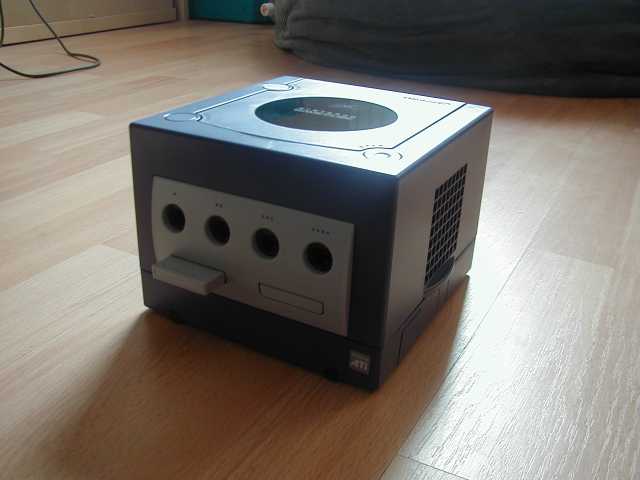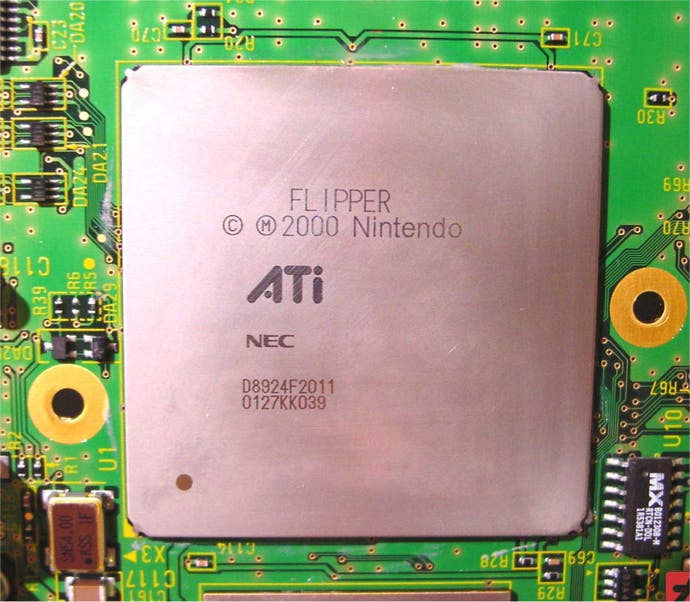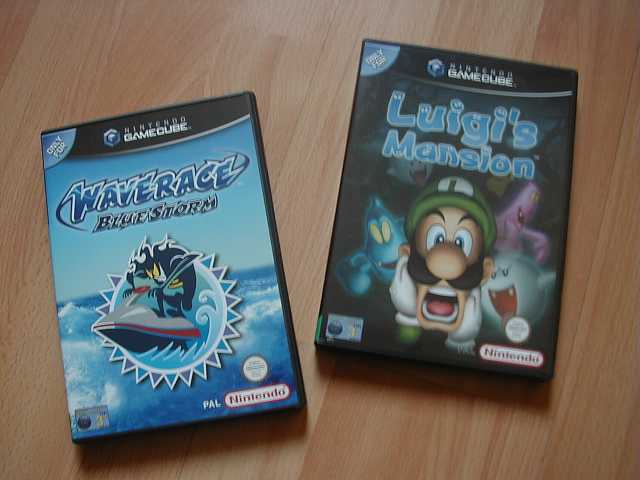Europe Cubed
Article - with the GameCube only a few days away, our resident Nintendite Mugwum picks it apart in his living room
It's finally here! On Friday, European gamers will be able to buy the coveted Nintendo GameCube for €199, or £129 in the UK, a price which, despite staggeringly low margins, many retailers are planning to honour in the hope of securing the most customers. The Cube has suffered numerous setbacks, including one of the longest transitions between Japan and Europe for yonks, lacklustre third party support, and a couple of niggles which only emerged once the darned thing was sat in our front room. The question is, will it emerge this Friday a handsome console with a number of strong titles at a sensible price, or would we be better off buying a real Fisher Price tape recorder?

Zany
It would be fair to say that I've been looking forward to the European release of the GameCube. There has been a Japanese machine, recently modified to accept American games, enjoying pride of place in my gaming bunker since three days after its domestic release. The name 'Nintendo' has always meant a lot to me - it's what I grew up with - and this latest console is the best they have ever produced.
For €199 gamers receive a console built out of quirky proprietary features. Take the game media, for example - eight centimetre DVDs, developed with Panasonic, capable of some high capacity data storage for as far as the bitty discs will stretch. Then consider the drive mechanism and operational buttons. The grey button in the top left as you look down on the roof of the Cube is the power button, with a software-based reset button (not a harsh, bone-jarring hardware one) sat in the bottom left. On its right is the tray release, with a slight indentation so you won't forget it. Hitting this button lifts the delicate tray lid, revealing the dinky mechanism onto which you place your discs. During operation, a yellow light in the shape of a smile beams at the player from the roof of the unit. It's happy to serve you!
On the front of the unit are four controller ports, matching the Xbox and Dreamcast quotients and moving ahead of the PlayStation 2. Two memory card ports are also included, but these are below the controller ports for some reason. Moving to the undercarriage, the Cube reveals a number of expansion ports, capable of accepting a broadband adapter or modem at some undefined point in the future, and further evaluation reveals a handy serial expansion port, although speculation as to what this might lead to would be a bit premature.

Flesh and Bone
Heading upstairs, the console's hardware is driven by a custom processing unit from IBM and ATI's graphics chip, codenamed Flipper. Although the console lacks Dolby Digital audio support for the true surround sound experience, Dolby Pro Logic II is supported, which goes someway to filling the void.
On the video front, output is available in RF (although we strongly recommend against the use of this horrendous standard), composite (an improvement, but still very grainy), and Europe's favourite, RGB (splitting the colour channels into red, green and blue through a bizarre number of pins, and producing the best signal possible from the hardware). After failing to support the standard with its N64 hardware, many feared the Cube would also be bound to S-Video, but as it happens this is not the case. In fact, in what will come as a shock to many - not least of all the many third party peripheral manufacturers whose GameCube S-Video cables are already on the market - the console simply does not output S-Video.
The reason for this is that the video encoder can only output in one or other of RGB and S-Video. Pulling a certain pin low on the encoder chip will output S-Video, and vice versa. This has been the basis for a handful of third party RGB modifications in the United States. Unfortunately for Nintendo, having not mentioned this, it seems likely that it will now incur the wrath of third party peripheral makers, as if failing to supply SDKs to third party developers in the UK wasn't bad enough. One thing that stands in its favour, however, is the borderless display and PAL60 support. Although some early games lack 60Hz support (notably Luigi's Mansion and Wave Race : Blue Storm), everything we have seen so far has been full screen. This is a console unlike the PlayStation 2 in that respect, and more like the Xbox. Perhaps if one Japanese company can get it right, the other one can with PlayStation 3…
Subtle
One of the things we do like about the GameCube, which might seem a little .. petty perhaps, is the console's nondescript packaging. Memory cards ship in GameBoy Advance software packaging, and controllers and cables receive handy boxes too, meaning less brutal stabbing of one's self in the arm is necessary whilst trying to separate hardware from titanium-based plastic bubble wrapping. I play games, I don't wield knives. Gimme a break.
The console packaging itself is a real triumph though. Easily the smallest box of any console in recent years, it contains the console itself, a manual (with a great deal less superfluous detail and warnings not to bludgeon your children to death with the console than its competition, I might add), a controller, a funky looking power cable (albeit proprietary, unlike the ubiquitous power cords employed by Sony and Microsoft) and a composite cable with left and right audio outputs and a SCART adapter for those without the separate RCA inputs on the front of the TV. The outside of the box features generous screenshots from a number of software titles, a rough rundown of the console's capabilities and, in a nice touch, a picture of the console and controller at their actual sizes.
Software packaging has been altered slightly from the US. Gone are the desperately cute cardboard-plastic crossover abominations from Japan, and in their place we have a DVD sized case with a memory card slot in the bottom left of the disc side and a standard manual holder on the left.

Games and Pricing
The GameCube's software line-up for 3rd May is fairly impressive. Led in theory by Miyamoto oddity Luigi's Mansion, but in practice by Factor 5's stupendous Star Wars Rogue Squadron II : Rogue Leader, it enjoys a handful of exclusive titles. For instance, you can't find Super Monkey Ball on any other format, and Wave Race : Blue Storm is a long overdue successor to one of the N64's launch titles. Unfortunately Nintendo has decided to stagger the European release of two of the console's finest titles; Super Smash Brothers Melee, a bizarre but wholly enjoyable beat 'em up featuring Nintendo characters, and Pikmin, another of Miyamoto's quirky creations. These games will materialise over the course of the next month or so.
Beyond the launch exclusives though, the console is to be populated by a cast of ports. EA will launch with the relatively dull (on first impressions at least) 2002 FIFA World Cup, their too-fast-to-handle cartoon racer Cel Damage, and flawed but enjoyable EA Sports BIG release NBA Street. Ubi Soft has wheeled out a trio of releases, the best of which is the sub-standard Batman : Vengeance, the other two being Disney titles, pandering to the stereotypical Nintendo buyer as opposed to the market predictions. Meanwhile Infogrames, apart from their handling Super Monkey Ball in Europe, will also parade Dreamcast export Sonic Adventure 2 in a new "Battle" guise, with support for the GameBoy Advance link-up.
Elsewhere, Acclaim has produced vaguely updated versions of thee of our favourite racers; Burnout, Crazy Taxi and Xtreme G3, the latter notable for its four player support. Supplementing the line-up further is Activision with Tony Hawk's Pro Skater 3 and Bloody Roar to complement its sure-fire LucasArts blockbuster, Rogue Leader. Rounding out the filed is Konami's ISS 2, and a couple of sure-fire failures - bam's Sylvester Stallone pay cheque Driven, and Kemco's hideously bad Universal Studios Theme Park Adventure. It's true that the GameCube has lots of games from day one, but yours truly would only recommend a handful of them. The good news is that it's still worth buying purely on the strength of the exclusives - all of which deliver plenty of entertainment - and a smattering of ports. At £129 for the console and £35 for software, it seems daft not to.
The Cube might be the best value console on the market, but if you wander down to your local gaming emporium this weekend with £165 in your pocket you'll come away ill-equipped. When you consider the cost of the GameCube (£129), a memory card (£14.99), a proper RGB SCART cable (£19.99) and a software title, you won't see much change from £200. If rumours of a PS2 price drop turn out to be true, and we've heard a lot to substantiate them, then the GameCube could fall by the wayside.
Conclusion
Nintendo will have a tough time catching up with Sony, but at this price and with a solid selection of software it stands as a good investment. Looking to the future, games like Super Mario Sunshine, Resident Evil 4, Eternal Darkness, Star Fox Adventures, Metroid Prime, Zelda and, in the meantime, Super Smash Brothers Melee and Pikmin, should keep you occupied. But you might want to get it in black so the girlfriend doesn't think you're fruity.

